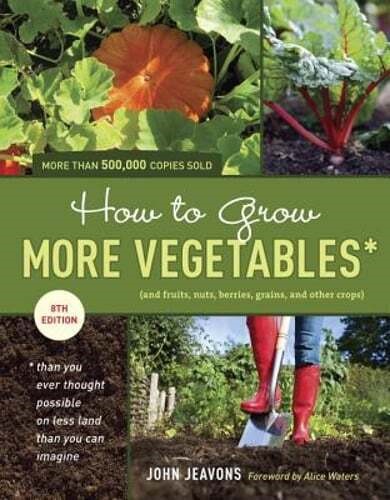HOW TO GROW MORE VEGETABLES
{and Fruits, Nuts, Berries, Grains, and Other Crops}

HOW TO GROW MORE VEGETABLES – In the early days at Chez Panisse, forty years ago, we had to scrounge for decent beans, pick lemons from neighbors’ trees, and hunt far and wide for a variety of produce of any quality whatsoever.
But farming has evolved in California. We now work with, at last count, nearly “fifty local, small-scale, family-run farms that grow —organically and sustainably—the seasonal fruits and vegetables that are the foundation of our cooking. In large part, we have John Jeavons to thank for this.
I met John on the twentieth birthday of Chez Panisse just as he was preparing for the twentieth anniversary of Ecology Action. We both had a lot to celebrate.
The work that John had begun in a small garden at Stanford had inspired small farms on nearly every continent; he had already worked with the Peace Corps in Togo, helped found an agricultural center in Kenya, taught in Mexico, and supported programs in Russia and the Philippines.
His work has gone right on inspiring, and at a pace that is fast enough to give us real hope that we will be able to grow sustainable communities around the world.
John’s methods are nothing short of miraculous. He John’s methods are nothing short of miraculous. He has shown that almost any soil can be prepared for the planting of food, and that astonishing quantities of high-quality produce can be grown on even the most devastated land. He has worked tirelessly to bring self-su1ciency to the poorest people in the poorest parts of the world.
As I write, he’s preparing to share his methods with the “vee thousand small-scale farmers from one hundred and thirty- one countries who are expected at Terra Madre, the biannual gathering of farmers in Turin, Italy, organized by the eco-gastronomes of Slow Food International. I can think of no more appropriate place for the dissemination of his ideas.
Vandana Shiva, the outspoken Indian food activist, has said that farms are zones of peace on this planet. A peaceful revolution in agriculture—what I like to call the delicious revolution—has begun, and John is one of its most brilliant leaders. How to Grow More Vegetables may be one of the most important how-to guides ever written.
ECOLOGYACTION GOAL: Act as a catalyst, instruct
teachers, and train students.
The work has always been worthwhile despite the continuing challenge of attracting strong, ongoing support. The biggest single asset to this undertaking is John Jeavons’s unfailing stamina and dedication.
Over and over, when we all ask, “Can it work?” he answers,
“How are we going to make it work?” It is becoming increasingly clear that GROW BIOINTENSIVE Sustainable Mini-Farming will be an important part of the solution to starvation and malnutrition, dwindling energy supplies, unemployment, and exhaustion and loss of arable land, if the social and political challenges can be met.
After forty years of testing, GROW BIOINTENSIVE food-raising has produced amazing bene2ts. Yields can average 2 to 6 times those of U.S. agriculture, and a few ranges up to 31 times higher—a plus at a time of peak food. But there’s still more to learn; for example, we are still working to develop an optimally healthy soil system.
Compost and calorie crops present the most challenges because they are crucial in meeting the nutritional needs of people and the soil. Experiments include alfalfa, fava beans, wheat, oats, cardoon, and comfrey.
So far, our yields are from one to 2ve times the U.S. average for these crops. Water use is well below that of commercial agriculture per pound of food produced and is about 33% to 12% that of conventional techniques per unit of land area. This is especially important in a world that has reached a point of peak water.
Energy expenditure, expressed in kilocalories of input, is 6% to 1% of that used by commercial agriculture, and this helps meet the challenge of peak oil. The human body is still more efficient than any machine we have been able to invent.
Several factors contradict the popular conception that this is a labor-intensive method. Using hand tools may seem to be more work, but the yields more than compensate. Even at 50¢ a pound wholesale, zucchini can bring as much as $18 to $32 per hour depending on the harvest timing because it is easy to grow, maintain, and harvest.
Time spent in soil to grow, maintain, and harvest. Time spent in soil preparation is more than oCset later in less need for weeding, thinning, cultivation, and other chores per unit of area and per unit of yield. Hand watering and harvesting appear to take the most time.
Initial soil preparation, including fertilization and planting, may take 5 to 9 1⁄2 hours per 100-square-foot raised bed. Thereafter, the time spent decreases dramatically.
A new digging tool, the U-bar, has reduced subsequent bed preparation time to as little as 20 minutes. A new hand watering tool that waters more quickly and more gently is also being developed.
Nature has answered our original queries with an abundance even greater than expected, and we have narrowed our research to the most important question that can be asked of any agricultural system: Is it sustainable?
The GROW BIOINTENSIVE1 method currently uses 50% or less of the purchased fertilizer that commercial farmers use. Can we maintain all nutrient levels on site, once they have been built up and balanced?
Or is some outside additive always necessary? We need to look more closely at all nutrients: nitrogen, phosphorus, potash, calcium, and trace minerals. Anyone can grow good crops on good soil, cashing in on nature’s accumulated riches.
READ MUCH MORE INSIDE… 545 Pages
DOWNLOAD “HOW TO GROW MORE VEGETABLES”

Collector’s Item $119.05

Click the Blue Button Below to Get Instant Access.
Our 100% Money Back Guarantee:

If for any reason you decided within 30 days that “HOW TO GROW MORE VEGETABLES” isn’t for you, simply notify us by email and we’ll gladly refund your money – no questions asked. That’s our Ironclad Guarantee!
The risk is entirely ours! You absolutely have nothing to lose!
[wpforms id=”97″]
Your Name and Email will Never Be Shared or Given to Anyone.
We keep our subscriber’s privacy sacred. We do not sell or rent your personal information to other parties. What’s more you can always unsubscribe at any time!
Warmest Regards,
Coyalita Linville
Copyright © 2023 – 2024 Sunrise-Sunset-Nature-Gardens.com. All Rights Reserved Privacy Policy – Earning Disclaimer – Terms of Use – Contact Us

